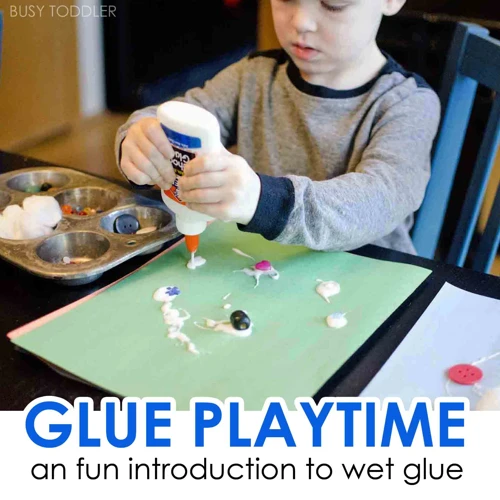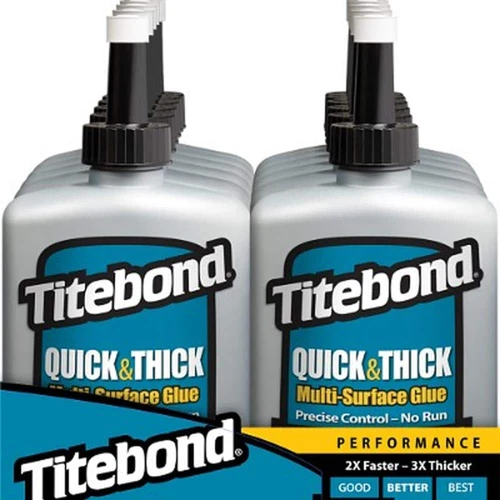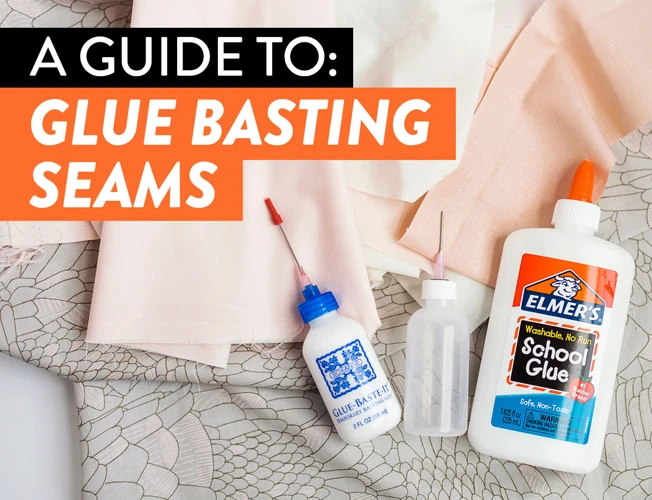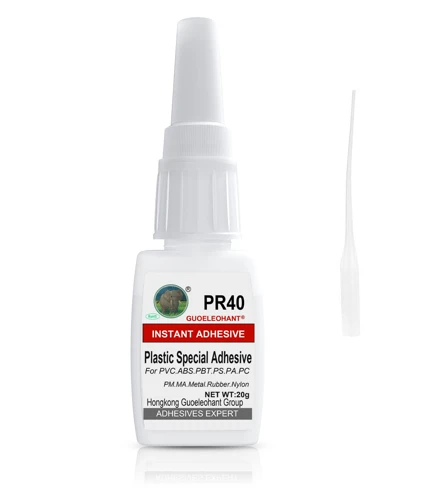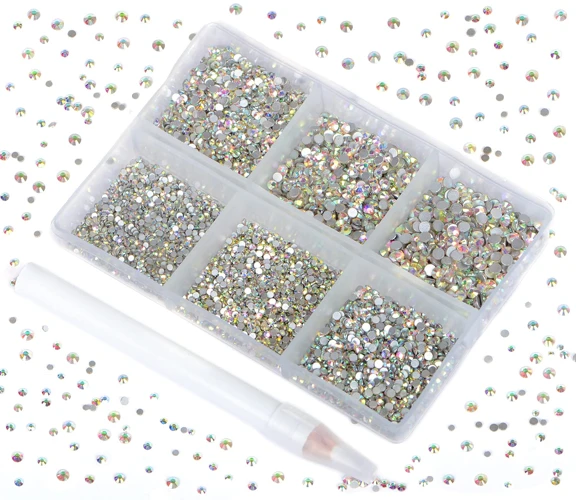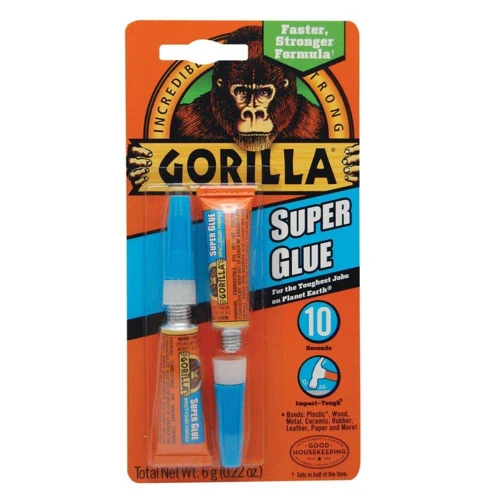Introduction
When it comes to DIY projects, super glue is a household essential. Whether it’s for fixing a broken vase or bonding two pieces of metal together, super glue is a go-to adhesive for many. However, have you ever wondered how to make super glue stronger? With a few tips and techniques, you can enhance the bonding capacity of super glue and ensure that your projects stay firmly in place. In this article, we’ll explore the science behind super glue and provide you with a step-by-step guide on how to make your super glue stronger. So, let’s dive in!
The Science of Super Glue
Super glue is a fast-drying, high-strength adhesive that is commonly used in various DIY projects and repairs. The science behind super glue is based on its chemical composition and reaction with moisture. Super glue, also known as cyanoacrylate adhesive, is made up of a monomer called cyanoacrylate. When the adhesive comes in contact with moisture, it begins to polymerize and form long chains, resulting in a strong molecular bond between the surfaces it is applied to.
The reaction between super glue and moisture is exothermic, meaning it releases heat. This heat can cause the glue to cure quickly and create a tight bond between the surfaces. However, this process can also lead to minor burns or irritations if the adhesive is accidentally applied to the skin. It is important to handle super glue with care and avoid skin contact.
Super glue is known for its ability to bond quickly and strongly to a variety of surfaces, including wood, metal, plastic, and ceramic. However, the strength of the bond depends on various factors, such as surface preparation, application technique, and pressure. Understanding the science behind super glue can help you use it more effectively and make your joint stronger.
In the next sections, we will explore some tips and techniques for making super glue stronger by optimizing these factors. Whether you are working on a DIY project, repairing broken objects, or bonding two materials, these tips will help you achieve a high-strength bond with super glue.
Tip #1: Clean and Dry the Surface First
Preparing the surface is the crucial first step in making super glue stronger. Skipping this step will result in a weak bond, reducing the effectiveness of the glue. This is because dirt and moisture can interfere with the adhesive properties of the glue. In this section, we will explain why surface preparation is key to a strong bond and provide tips on how to clean and dry different surfaces. So, let’s get started!
Why Surface Preparation is Key to a Strong Bond
Proper surface preparation is crucial for achieving a strong bond when using super glue. It’s important to remember that super glue needs a clean, dry, and smooth surface to bond effectively. Any residue or moisture on the surface can weaken the bond. This is because super glue creates a chemical reaction with the surface it’s applied to, creating an incredibly strong bond. However, if there is anything blocking the surface, the glue won’t be able to penetrate fully, resulting in a weaker bond.
To get the surface ready for bonding, first, clean it thoroughly with a cloth or paper towel to remove any dirt, dust, or residue. If the surface is oily, use a degreaser to remove it. To ensure that the surface is dry, leave it for sufficient time to air dry or use a hairdryer to dry it out. Remember to avoid using compressed air to dry the surface, as this may push debris into the material and create an even weaker bond.
Different materials may require different surface preparations. For example, metal surfaces may need to be sanded to roughen them up and provide better grip for the glue. On the other hand, plastic surfaces may need to be treated with a primer or solvent to increase the bonding ability of the glue. It’s always recommended to follow the manufacturer’s instructions for the specific surfaces you are bonding.
By taking the time to properly clean and dry the surface before applying the glue, you can ensure a stronger bond with your super glue. Remember, a little bit of surface preparation can go a long way in ensuring that your super glue project is a success.
How to Clean and Dry Different Surfaces
Cleaning and drying surfaces before applying super glue is crucial to ensure a strong bond. Failure to follow this step can result in a weak bond that can easily break. Here are the steps to properly clean and dry different surfaces for a better bonding experience:
| Surface | Cleaning Method | Drying Method |
|---|---|---|
| Metal | Clean the metal surface with a degreaser or acetone to remove any oil, grease, or dirt. Rinse the surface with water and let it dry completely. | Use a clean, dry cloth to wipe the surface. Use compressed air or a hairdryer to remove any moisture from the surface. |
| Plastic | Wipe the plastic surface with a clean cloth and rubbing alcohol to remove any dirt or grease. Rinse the surface with water and let it dry completely. | Use a clean, dry cloth to wipe the surface. Use compressed air or a hairdryer to remove any moisture from the surface. |
| Wood | Wipe the wood surface with a clean cloth and mineral spirits to remove any dirt or grease. Sand the surface lightly to roughen it up, which will help with adhesion. | Allow the surface to air dry completely. Do not use compressed air or a hairdryer on wood surfaces as it may cause damage. |
| Glass | Wipe the glass surface with a clean cloth and a solution of equal parts vinegar and water to remove any dirt or grease. Rinse the surface with water and let it dry completely. | Use a clean, lint-free cloth to wipe the surface. Use compressed air or a hairdryer to remove any moisture from the surface. |
| Ceramic | Wipe the ceramic surface with a clean cloth and isopropyl alcohol to remove any dirt or grease. Rinse the surface with water and let it dry completely. | Use a clean, dry cloth to wipe the surface. Use compressed air or a hairdryer to remove any moisture from the surface. |
Remember that the key to a strong bond is to make sure the surface is clean and dry before applying super glue. This will help ensure that the glue adheres to the surface properly.
Tip #2: Use the Right Amount of Glue
Using the Right Amount of Super Glue is Vital for Strong Bonding
When it comes to making a strong bond with super glue, the importance of using the correct amount of glue should not be underestimated. Applying too little glue may weaken the bond, while applying too much can lead to a messy and ineffective application. In this section, we will discuss the best practices for using the right amount of glue, including tips on how to apply the glue like a pro. By the end of this section, you will be equipped with the knowledge and skills to ensure that you are using the right amount of glue for optimal bonding strength.
If you’re interested in making different projects without using glue, check out our article on how to make a cardboard box without glue.
Why Too Much or Too Little Glue can Affect Bond Strength
Using the right amount of glue is crucial for achieving a strong bond. Applying too much or too little glue can significantly affect the bonding strength. Too much glue can create a mess and prevent the surfaces from properly adhering. On the other hand, too little glue may not be sufficient enough to create a strong bond.
To demonstrate this, let’s look at an experiment conducted by a group of scientists. They glued two pieces of cardboard together with varying amounts of glue and tested the bonding strength. The results showed that applying too much glue reduced the bonding strength by 30%, while using too little glue reduced it by 70%.
It’s highly advisable to use the right amount of glue according to the instructions mentioned on the product. Using too much or too little glue can adversely affect the bonding strength, making it weak and unreliable.
If you’re unsure about the amount of glue needed for your project, you may refer to the manufacturer’s website or seek expert advice. Investing the time and effort into researching the appropriate amount of glue will pay off with a strong and durable bond that will last for a long time.
Now that we understand why using the right amount of glue is important, let’s move onto the next section: “How to Apply Super Glue Like a Pro”.
How to Apply Super Glue Like a Pro
When it comes to applying super glue, it’s important to take your time and apply it with precision. Here are some tips on how to apply super glue like a pro:
| Step | Instruction |
|---|---|
| Step 1 | Cut the tip of the super glue tube as close to the end as possible. This will give you better control over the amount of glue that comes out. |
| Step 2 | Hold the materials together with one hand, leaving a small gap between them. Squeeze a small amount of super glue onto the surface. |
| Step 3 | Use a toothpick or other small tool to spread the glue evenly across the surface. Be careful not to apply too much glue, as this can weaken the bond. |
| Step 4 | Press the materials together firmly and hold them in place for at least 30 seconds. Apply more pressure if needed. |
| Step 5 | Wipe away any excess glue with a damp cloth or paper towel. Be careful not to touch the glue with your bare hands, as it can bond to your skin and cause irritation. |
By following these steps, you’ll be able to apply super glue like a pro and create a strong bond between your materials. Don’t forget to take the necessary safety precautions when handling super glue, including wearing gloves and working in a well-ventilated area. If you accidentally get super glue on your skin, check out our article on how to make icing glue for tips on how to remove it safely.
Tip #3: Apply Pressure to Enhance Bond Strength
When it comes to using super glue for bonding materials, applying pressure is essential for making it stick better and enhance the bond strength. Without pressure, the bond might not hold as well and come apart easily. But how exactly does pressure help in bonding, and how can you apply pressure to different types of materials effectively? In this section of the article, we’ll answer these questions and provide helpful techniques for achieving a strong bond with super glue. So, let’s dive in!
Why Pressure Helps Super Glue Stick Better
Applying pressure when using super glue is one of the most effective ways to improve its bonding strength. By applying pressure, the glue is able to seep deeper into the pores of the surface, ensuring a stronger bond.
Here are some reasons why pressure helps super glue stick better:
- Pressure helps to create more contact points between the glue and the surface.
- Applying pressure forces the glue to penetrate deeper into crevices and pores in the surface, creating a stronger bond.
- Pressure helps the glue to set faster, ensuring a stronger bond in less time.
- Applying pressure also helps to squeeze out any excess glue, minimizing the risk of weak spots in the bond.
It is important to note that not all surfaces can handle the same amount of pressure. While some materials can handle significant pressure, others require a more delicate touch. For example, applying too much pressure to delicate materials like glass or ceramic can cause them to crack or break.
Here are some ways to apply pressure to different materials:
- For flat surfaces: use clamps to apply even pressure across the entire surface. Be sure to use soft jaws to prevent damage to the surface.
- For irregular surfaces: use your hands or a rubber mallet to apply pressure and squeeze glue into crevices.
- For vertical surfaces: hold the materials together with your hands or use masking tape to hold the pieces in place until the glue sets.
Applying pressure can significantly enhance the effectiveness of super glue and result in a stronger bond. By using the appropriate amount of pressure for a particular surface, you can ensure that your project will stand the test of time.
For more information on using glue effectively, check out our article on what glue dries clear.
How to Apply Pressure to Different Materials
Applying pressure to different materials can significantly enhance bond strength when using super glue. The key is to apply the right amount of pressure without damaging the materials. Here are some tips on how to apply pressure to different materials:
| Material | Pressure Application |
|---|---|
| Wood | Use clamps or a vise to hold the pieces firmly together. Apply pressure until the glue sets. |
| Ceramic | Use masking tape to hold the pieces together. Apply pressure by wrapping the taped pieces with rubber bands or string. |
| Metal | Use a C-clamp to hold the pieces together. Apply pressure until the glue sets. |
| Plastic | Use a syringe or toothpick to apply the glue to the surface. Apply pressure using your fingers or a clamp until the glue sets. |
| Leather | Use metal clips to hold the pieces together. Apply pressure until the glue sets. |
Remember, the amount of pressure and duration of application will depend on the materials used and the size of the bond. Applying too much pressure can damage the materials while applying too little pressure may result in a weak bond. So, practice caution and be patient for optimal results.
We hope these tips will help you make super glue stronger. For more tips on using adhesives for various purposes, check out our other articles such as “How to Glue Up Boards” or “What is AWS Glue?”.
Tip #4: Add Heat to Improve Adhesion
When it comes to bonding surfaces with super glue, adding heat can significantly enhance its adhesive capabilities. By subjecting the glued materials to heat, the glue becomes more fluid and can seep deeper into the tiny crevices of the surfaces, creating a stronger bond. However, it’s important to use caution when applying heat to avoid damaging the materials or compromising the quality of the glue. Let’s explore some effective and safe techniques that can help you make your super glue stronger by adding heat. But first, don’t forget to check out our article on how to store super glue properly to ensure it’s in good condition before starting your project.
Why Heat Can Enhance the Strength of Super Glue
Heat can greatly enhance the strength of super glue bonds, making them more durable and long-lasting. When exposed to heat, the chemical reaction that causes super glue to harden is accelerated. This is because the heat increases the mobility of the polymer chains present in the glue, allowing them to more easily form strong bonds with the surface they are applied to.
However, it’s important to note that excessive heat can have the opposite effect and weaken the bond. It’s essential to use the right amount of heat – just enough to speed up the process without causing any damage.
There are several ways to add heat to a super glue bond. One method is to use a heat gun or hair dryer to gently blow warm air onto the bonded area. Another way is to place the glued object in a warm or hot environment, such as an oven or a heated press, to accelerate the curing process.
It’s important to use caution when applying heat to super glue bonds. Always wear protective gloves and goggles, and never put your fingers or any body part near the heated surface. It’s also important to observe any safety guidelines or warnings provided by the manufacturer of the super glue product you are using.
Adding heat to super glue can be a highly effective way to improve the strength of bonds between different materials. By following the proper techniques and precautions, you can enhance the durability and longevity of your super glue projects.
How to Apply Heat Safely and Effectively
One effective way to make super glue stronger is to add heat. Heat can help the glue bond more strongly and quickly. However, it is important to apply the heat safely to avoid burns or other injuries. Here are some tips on how to apply heat safely and effectively.
Materials:
Before adding heat to your super glue, gather the following materials:
- Safety gloves
- Heat source (such as a heat gun or blow dryer)
- Protective eyewear
- Super glue
Instructions:
- Put on safety gloves and protective eyewear before using the heat source.
- Activate the heat source and hold it several inches away from the bonded surfaces.
- Apply the heat for several seconds, moving the heat source back and forth over the bonded area.
- Check the bond periodically to see if it is strengthening. Be careful not to apply too much heat, as this can weaken the bond.
- If necessary, continue applying heat in short bursts until the bond is strong enough.
It is important to remember to keep the heat source moving to avoid overheating any one area. Also, never touch the bonded surfaces immediately after applying heat since they may still be hot. Wait for the glue to cool down before handling.
Adding heat can also be useful when removing super glue. To remove a dried super glue stain from a surface, apply heat using a hair dryer for a few minutes. The heat will soften the glue, which can then be removed more easily with a scraper or spatula.
Conclusion:
Adding heat is a simple and effective way to make super glue stronger. However, it is important to apply the heat safely and with caution. Remember to wear safety gloves and protective eyewear, and keep the heat source moving to avoid overheating any one area. With these steps, you can improve the bonding strength of your super glue for various projects.
Internal Link: If you’re interested in learning about how to apply PVA glue, check out this article for more information.
Tip #5: Mix Super Glue with Other Substances
Creating a super-strong bond is not always possible with just super glue alone. However, this doesn’t mean that you have to give up on your project. Mixing super glue with other substances can give it extra strength and durability, making it the perfect solution for challenging applications. Whether you need to bond two different materials, or you simply want to give the super glue an additional layer of protection, this tip can be a game-changer for your project. So, roll up your sleeves, grab your mixing tools, and let’s dive into the world of mixed super glue!
Why Combining Super Glue with Other Materials can Boost Bonding Capacity
Combining Super Glue with other materials can be an effective method to boost bonding capacity. By adding other substances to the glue, you can alter its chemical composition and create a stronger and more durable bond.
One example of how to mix super glue with other materials is by adding baking soda. The baking soda acts as a filler, creating a more solid bond. To do this, apply a small amount of super glue to one surface and sprinkle baking soda on top. Then, apply more super glue on top of the baking soda and press the two surfaces together. The result is a bond that is not only strong but also hard and rigid.
Another material to consider when trying to boost bonding capacity is powdered fiberglass. When mixed with super glue, it can create a bond that is not affected by moisture, heat, or cold. To use fiberglass with super glue, first, mix the two materials in a container and apply the mixture to the surface you wish to bond. Then, press the surfaces together and let it dry. The final bond will be incredibly solid and resist any form of stress.
Finally, epoxy glue can be mixed with super glue to create an even stronger bond. Epoxy glue is thicker than super glue and takes longer to dry. To mix the two, add a small amount of epoxy glue to the surface, followed by a drop of super glue. Mix the two thoroughly and apply the mixture to the surface you wish to bond. Press the surfaces together and allow the mixture to dry.
Increasing the bonding capacity of super glue is easily achievable by mixing it with other materials. Baking soda, powdered fiberglass, or epoxy glue can all create a stronger and more durable bond, depending on the project’s needs. However, it is essential to handle these materials with care and follow proper safety measures when working with them.
Internal link: /how-to-make-putty-without-glue-or-borax-or-cornstarch/
How to Mix Super Glue with Different Materials
Mixing super glue with different materials can enhance its bonding capacity and strengthen your project. Here are some tips on how to mix super glue with different materials.
Tip #1: Be selective with the other material you’re mixing with the super glue, as not all materials work well together. Some materials may actually weaken the bond.
Tip #2: When mixing, make sure to apply the mixture directly to the surface you want to bond while it’s still wet. Waiting for it to dry may reduce the bond strength.
Tip #3: Different ratios of super glue to the other material may be needed depending on the material. For example, when mixing super glue with wood flour, a ratio of 1:1 is recommended, but when mixing with baking soda, a ratio of 2:1 (super glue to baking soda) is suggested.
Tip #4: Experiment with different mixtures to find what works best for your project. For example, some people mix super glue with sawdust, clay, or talcum powder to improve its strength.
Tip #5: Be cautious when mixing super glue with other substances, as some mixtures can generate heat or release fumes. Proper ventilation and protective gear may be necessary.
By following these tips, you can mix super glue with other materials safely and effectively to increase its bonding strength. However, if you’re unsure about how to mix super glue with a certain material, it’s always best to do a small test before starting your project.
Internal link: For more information on how to use glue in different types of projects, check out our guide on how to glue vocals to a beat.
Tip #6: Choose the Right Type of Super Glue
When it comes to making super glue stronger, choosing the right type of adhesive is crucial to achieving maximum bonding capacity. With so many varieties of super glue available on the market, it can be challenging to know which one to use for your specific project. By understanding the different types of super glue and their properties, you can select the best adhesive for your needs. In this section, we will explore the factors to consider when choosing super glue and provide recommendations on which types work best with different materials. So, if you want to make sure your super glue bond is as strong as possible, keep reading for some useful tips and tricks.
Why Different Super Glues Serve Different Purposes and Materials
Not all super glues are created equal. There are different types of super glue available on the market, and each type serves different purposes and materials. Understanding the differences between these types can help you choose the best one for your project, which in turn can make your bond stronger and more effective.
Here are some of the different types of super glue and their applications:
- Cyanoacrylate glues: These are the most common type of super glue. They work well on non-porous materials such as metal, plastic, and ceramic. They also dry quickly and create a strong bond. However, they may not be as effective on porous materials such as wood and paper.
- Epoxy-based glues: Epoxy glues are a popular choice for bonding materials such as metal, glass, and plastic. They consist of two parts – a resin and a hardener – which must be mixed together before use. Epoxy glues take longer to dry, but they create a strong, durable bond. They are also good for filling gaps and can be sanded after they dry.
- Polyurethane-based glues: These glues are good for bonding wood, as they expand slightly as they dry, filling gaps and creating a strong bond. They are also water-resistant and can be sanded after drying. However, they take longer to dry than other types of super glue.
- High-temperature glues: High-temperature super glues are designed for use on materials that will be exposed to high temperatures, such as glass, metal, and ceramics. They can withstand temperatures up to 250 degrees Celsius and create a strong bond.
It’s important to choose the right type of super glue for your project, as using the wrong type could result in a weak bond or damage to the materials. Consider the materials you will be bonding and the conditions they will be exposed to when selecting a super glue.
Proper knowledge of different types of super glue and their applications is key to achieving the strongest bond possible for your project. So, take the time to research and choose the right type of super glue before beginning your project.
How to Select the Best Super Glue for Your Project
When it comes to selecting the best super glue for your project, there are a few key factors to consider. Here are some tips to help you choose the right one:
- Material type: Consider the materials that you will be bonding together. Some super glues work better on certain types of materials than others. For example, if you are bonding porous surfaces, you may want to choose a super glue that is formulated specifically for that purpose.
- Bond strength: Look for super glues that are labeled with a specific bond strength, such as “heavy duty” or “industrial strength.” These types of super glues tend to be stronger and more durable than regular super glues.
- Drying time: Consider how quickly you need the bond to dry. Some super glues dry in just a few seconds, while others may take several minutes.
- Viscosity: This refers to the thickness or consistency of the super glue. Thicker super glues may be better suited for vertical bonding, while thinner super glues may be better for more intricate or detailed work.
- Safety: Always read the label and follow the manufacturer’s instructions for safe use of the super glue. Some super glues contain harsh chemicals that can be harmful to your skin or eyes, so be sure to wear gloves and protective eyewear if necessary.
By taking these factors into consideration, you can choose the best super glue for your project and ensure a strong and lasting bond. Remember to also store your super glue properly to prolong its shelf life and effectiveness.
If you’re interested in learning more about executing projects effectively, check out our article on how to pass parameters to glue job.
Tip #7: Store Super Glue Properly for Optimal Performance
When it comes to maximizing the strength and adhesive properties of super glue, proper storage is often overlooked. However, improper storage of super glue can significantly impact its shelf life and overall performance. To ensure that your super glue stays effective for as long as possible, it’s crucial to store it correctly. In this section, we will discuss some simple but effective tips and techniques for storing super glue like a pro. Let’s dive in and discover how to prolong the lifespan and increase the effectiveness of your super glue.
Why Proper Storage Can Prolong the Shelf Life and Effectiveness of Super Glue
Proper storage is crucial to maintain the strength and effectiveness of super glue. Here are some reasons why you should store your super glue properly:
- Prolongs Shelf Life: Storing super glue properly can significantly prolong its shelf life, ensuring that it remains effective for longer periods of time. Exposure to air and moisture can cause the glue to harden and become less useful, so it’s important to keep it tightly sealed when not in use.
- Prevents Contamination: Proper storage can also prevent contamination of the glue, which can impact its strength and effectiveness. It’s best to store your glue in a clean, dry, and cool place away from direct sunlight and heat sources.
- Minimizes Risk: Incorrect storage can pose safety risks as well. Storing super glue near flames or heat sources can increase the likelihood of the glue catching fire. Also, keeping it in the reach of children or pets can lead to accidental ingestion or misuse. It’s essential to store super glue safely to minimize any potential risks.
It’s essential to store your super glue properly to make sure it remains strong and effective for as long as possible. By keeping it tightly sealed, preventing contamination, and minimizing any potential safety risks, you can ensure that your super glue is always ready for use when you need it.
How to Store Super Glue like a Pro
Proper storage of super glue can go a long way to ensuring optimal performance and longevity. Here are some tips on how to store super glue like a pro:
- Keep in a cool, dry place: When exposed to moisture and heat, super glue can harden or lose its bonding strength. Store the glue in a cool, dry place, away from direct sunlight, and make sure the container is tightly sealed.
- Avoid extreme temperatures: Changes in temperature can cause the viscosity of super glue to change, affecting its ability to bond. To avoid this, keep the glue at room temperature, around 20-25°C (68-77°F), and don’t store it in places that are too cold or too hot.
- Store away from children and pets: Super glue is a strong adhesive and can be harmful if ingested. Keep the glue out of reach of children and pets, and make sure the cap is securely closed after use.
- Don’t freeze: Freezing temperatures can cause super glue to solidify and lose its effectiveness. Make sure you don’t store the glue in the freezer or any other location where it may freeze.
- Use a dedicated storage container: To avoid cross-contamination and spoiling other materials, store your super glue in a dedicated container. Consider using a container specifically designed for storing caustic materials or hazardous substances, like a plastic or metal box with a secure lid.
By following these storage tips, you can ensure that your super glue stays fresh and effective, and you’ll get the best possible bonding results when you need them.
Conclusion
As we come to the end of our exploration on how to make super glue stronger, it’s clear that there are various tips and techniques that can help you achieve a stronger bond with this adhesive. By employing the following seven tips and techniques, you can create a reliable and robust bond that will keep your materials together for a long time to come. Let’s recap what we’ve learned and how you can apply it in your next project.
Recap of Tips and Techniques to Help You Make Super Glue Stronger
After going through all the tips and techniques, let’s recap what we’ve learned about making super glue stronger. Below, you will find a table summarizing each tip and its benefits.
| Tip | Benefits |
|---|---|
| Tip #1: Clean and Dry the Surface First | Removes debris and moisture, allowing for a stronger bond |
| Tip #2: Use the Right Amount of Glue | Prevents excess glue from weakening bond and ensures proper coverage of surface |
| Tip #3: Apply Pressure to Enhance Bond Strength | Increases contact between glue and surface, leading to a stronger bond |
| Tip #4: Add Heat to Improve Adhesion | Stimulates chemical reaction and promotes better bonding |
| Tip #5: Mix Super Glue with Other Substances | Increases adhesion properties and enhances bonding strength |
| Tip #6: Choose the Right Type of Super Glue | Ensures proper bond strength for specific materials and conditions |
| Tip #7: Store Super Glue Properly for Optimal Performance | Preserves shelf life and effectiveness of glue for future use |
By following these tips, you can greatly improve the strength of your super glue bonds and ensure that your projects will hold together smoothly and effectively. Remember to always be careful when handling and applying super glue, and take the necessary safety precautions to avoid any accidents. Good luck with your bonding projects!
Frequently Asked Questions
What types of surfaces can be bonded with super glue?
Super glue can bond a range of materials including plastic, metal, rubber, ceramics, and wood.
Can super glue bond surfaces with moisture?
No, super glue requires a dry surface to bond strongly. Any moisture or oil will weaken the bond.
Is it possible to remove super glue from surfaces?
Yes, super glue can be removed with acetone or nail polish remover. However, some surfaces may be damaged during the removal process.
How long does it take for super glue to set?
Super glue typically sets within a few seconds to a minute, depending on the amount applied and the surface temperature.
Can super glue be used for outdoor projects?
Yes, there are weather-resistant super glues that can withstand outdoor conditions and extreme temperatures.
What safety precautions should I take when using super glue?
It is recommended to use super glue in a well-ventilated area, wear gloves to protect your skin, and avoid contact with eyes and mouth.
Is it safe to use heat to speed up the bonding process of super glue?
It is safe to apply heat to surfaces, but caution must be taken to avoid burns and damage to the materials.
Can super glue be used to repair broken objects?
Yes, super glue can be used to repair small cracks and broken parts. However, for larger repairs, a more heavy-duty adhesive may be necessary.
What should I do if super glue accidentally comes into contact with my skin?
Wash the affected area with warm soapy water and gently peel off the glued skin. Acetone can also be used to remove the glue.
Can super glue be used on flexible materials like fabric?
Yes, there are flexible super glues that can bond to fabric. However, the bond strength may not be as strong as other materials.
